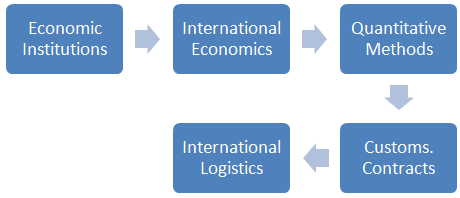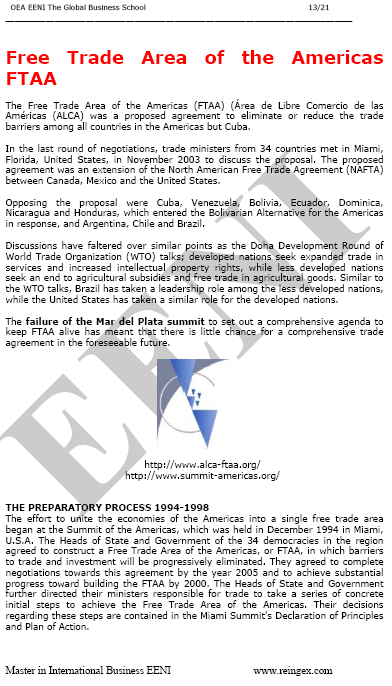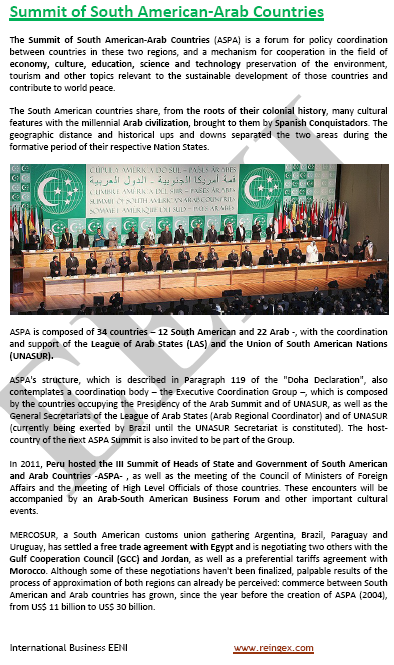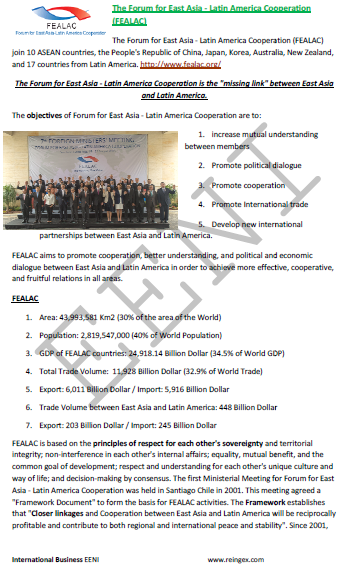Adaptation to the Latin American and Caribbean Students
Adaptation of the Bachelor of Science to the Latin American and Caribbean Students (Bachelor of Science in International Trade, e-learning, second semester)
Adaptation of the Bachelor of Science to the Latin American and Caribbean Students (Bachelor of Science in International Trade, e-learning, second semester).
| Bachelor of Science in International Trade |

Subject - “Adaptation of the Bachelor of Science to the Latin American and Caribbean Students (Study of the main Latin American economic institutions)” - Bachelor of Science in International Trade (second semester).
Proposed topics for Latin American and Caribbean Students:
Syllabus of the Program - Organization of American States (OAS).
- Introduction to the Organization of American States
- Objectives, strategies and principles of the Organization of American States
- Structure and member states of the OAS
- Accompaniment mechanisms of the Organization of American States
- International Trade Information System (SICE)
- Trade Agreements in America
- Summit of the Americas
- Free-Trade Area of the Americas (ALCA)
- Organization of American States and the global crisis
- Inter-American Convention against corruption
Objectives of the Program “Organization of American States (OAS)”:
- To understand the objectives of the Organization of American States
- To know the importance of the Summit of the Americas
- To understand the causes of the failure of the free-trade area of the Americas
- To analyze the trade agreements in America
The Members of the Organization of American States are Argentina, Bolivia, Brazil, Canada, Chile, Colombia, Costa Rica, Cuba, Dominican Republic, Ecuador, El Salvador, Guatemala, Haiti, Honduras, Mexico, Nicaragua, Panama, Paraguay, Peru, the U.S., Uruguay, the Bolivarian Republic of Venezuela, Barbados, Trinidad and Tobago, Jamaica, Grenada, Suriname, Dominica, Saint Lucia, Antigua and Barbuda, Saint Vincent and the Grenadines, the Bahamas, Saint Kitts and Nevis, Belize, and Guyana.
Syllabus of the Program - Latin American economy and International Trade
- Latin American Economy
- Economic profile of Latin America (Iberian America)
- Effects of the global crisis in Latin America and the Caribbean
- Stage after crisis
- Key Challenges of the Latin American Economy: innovation and technological change
- Foreign Trade of the Latin American Countries
- Economic relations between China and Latin America (Iberian America)
- Role of China and other Emerging economies
- Regional integration in Latin America and the Caribbean
- Analysis of the Rapport on Latin American Economy and the Caribbean published by the ECLAC
Objectives of the Program “Latin American Economy”:
- To analyze the Latin American Economy evolution
- To analyze the intra-Latin American Foreign Trade
- To evaluate the effects of the global crisis in the region
- To study the trade relations of China with the Latin American Countries
- To evaluate the degree of Latin American Economic Integration
Syllabus of the Program - Inter-American Development Bank.
- Introduction to the Inter-American Development Bank (IADB)
- Operative and organization chart of the Inter-American Development Bank
- Integration of Regional Infrastructure in South America (IIRSA)
- Inter-American Investment Corporation
- Multilateral Investment Fund (FOMIN)
- Project cycle of the Inter-American Development Bank
Objectives of the Program “Inter-American Development Bank”:
- To understand the objectives, structure and functions of the Inter-American Development Bank (IADB)
- To know the Multilateral Investment Fund, the Integration of Regional Infrastructure in South America and the Inter-American Investment Corporation
- To evaluate the funds and financial instruments of the Inter-American Development Bank
- To understand the functioning of the projects and operations of the IADB
Syllabus of the Program - Economic Commission for Latin America and the Caribbean (ECLAC)
- Introduction to the Economic Commission for Latin America and the Caribbean (ECLAC) of the UN
- Objectives of the Economic Commission for Latin America (Iberian America)
- Member countries of the ECLAC
- History of the Economic Commission for Latin America and the Caribbean
- Economic Reports of the Economic Commission for Latin America and the Caribbean (ECLAC)
- Economic development in Latin America (Iberian America)
Objectives of the Program “Economic Commission for Latin America (ECLAC)”:
- To understand the objectives (regional integration, Latin American economic development...) and the structure of the ECLAC
- To know the Economic Reports of the Economic Commission for Latin America (Iberian America)
- To analyze the economic development in Latin America (Iberian America)
The members of the Economic Commission for Latin America and the Caribbean are Antigua and Barbuda, Argentina, the Bahamas, Barbados, Belize, Bolivia, Brazil, Canada, Chile, Colombia, Costa Rica, Cuba, Dominica, the Dominican Republic, Ecuador, El Salvador, France, Germany, Grenada, Guatemala, Guyana, Haiti, Honduras, Italy, Jamaica, Japan, Mexico, the Netherlands, Nicaragua, Panama, Paraguay, Peru, Portugal, South Korea, Saint Kitts and Nevis, Saint Lucia, Saint Vincent and the Grenadines, Spain, Suriname, Trinidad and Tobago, the UK, the U.S., Uruguay, and Venezuela.
The associate members are Anguilla, Aruba, British Virgin Islands, Montserrat, the Netherlands Antilles, Puerto Rico, Turks and Caicos Islands, the U.S. Virgin Islands.
Syllabus of the Program: Forum for East Asia-Latin America Cooperation.
- Introduction to the Forum for East Asia-Latin America Cooperation
- Objectives and organization of the Forum for East Asia-Latin America Cooperation
- Action Plan of Manila
- Economic profile of the countries of the Forum for East Asia-Latin America Cooperation
- Introduction to the economic and trade relations between Latin America and Asia
Objectives of the Program “Forum for East Asia-Latin America Cooperation (FEALAC)”:
- To understand the objectives and organization of FEALAC
- To analyze the economic relations between Asia and Latin America (Iberian America)
- To understand the concept of FEALAC as the “missing link” between Latin America and Asia
Latin American FEALAC Members: Argentina, Bolivia, Brazil, Chile, Colombia, Costa Rica, Cuba, the Dominican Republic, Ecuador, El Salvador, Guatemala, Mexico, Nicaragua, Panama, Paraguay, Peru, Uruguay, anVenezuela.
Syllabus of the Program - Summit of South American-Arab Countries (ASPA).
- Introduction to the Summit of South American-Arab Countries
- Structure of coordination and the organization chart of the ASPA
- III Summit ASPA. Lima, Brasilia and Doha Declaration
- The UNASUR and the Arab League
Objectives of the Program “Summit of South American-Arab Countries (ASPA)”:
- To understand the objectives of the Summit of South American-Arab Countries
- To know the functioning of the ASPA
- To analyze the areas of cooperation of the Summit of South American-Arab Countries (ASPA)
The Latin America member countries of the ASPA are Argentina, Brazil, Bolivia, Colombia, Chile, Ecuador, Guyana, Paraguay, Peru, Suriname, Uruguay, and Venezuela.
Syllabus of the Program - Africa-South America Summit (ASA)
- Introduction to Africa-South America Summit (ASA)
- III Africa-South America Summit
- Implementation Plan Africa-South America
- Statements of Malabo, Abuja and Nueva Esparta
- UNASUR and the African Union
Objectives of the Program “Africa-South America Summit (ASA)”:
- To understand the objectives of the Africa-South America Summit
- To know the Implementation Plan Africa-South America
- To analyze the economic relations between the countries of South America and Africa
Syllabus of the Program - Community of Latin American and Caribbean States (CELAC).
- Introduction to the Community of Latin American and Caribbean States (CELAC)
- Trade Relations of the EU with Latin America and the Caribbean
- Summit EU-CELAC (EU, Latin America, the Caribbean)
- Action Plan EU-CELAC
- Relations EU-MERCOSUR
- Relations EU-Andean Community
- Relations EU-Central America
- Relations EU-Caribbean
The objective of the subject “Community of Latin American and Caribbean States (CELAC)” is to understand the objectives and functions of the CELAC.
Latin American CEALAC countries: Argentina, Belize, Bolivia, Brazil, Chile, Colombia, Costa Rica, Ecuador, El Salvador, Guatemala, Guyana, Honduras, Mexico, Nicaragua, Panama, Paraguay, Peru, the Dominican Republic, Uruguay, and Venezuela.
The Caribbean CEALAC countries: Antigua and Barbuda, the Bahamas, Barbados, Dominica, Grenada, Haiti, Jamaica, Montserrat, Saint Kitts anNevis, Saint Lucia, Saint Vincent and the Grenadines, Suriname and Trinidaand Tobago.
Subjects of the second semester of the Bachelor of Science in International Trade.

ECTS: European Transfer and Accumulation System
Samples: adaptation of the Bachelor of Science to the Latin American and Caribbean Students (Study of the main Latin American economic institutions) (Bachelor of Science in International Trade, e-learning, second semester).





Language of the subject “adaptation of the Bachelor of Science to the Latin American and Caribbean Students (Study of the main Latin American economic institutions)” of the Bachelor of Science in International Trade (second semester):  or or
or or  EENI
EENI  EENI
EENI  EENI.
EENI.
(c) EENI Global Business School (1995-2024)
We do not use cookies
Top of this page

